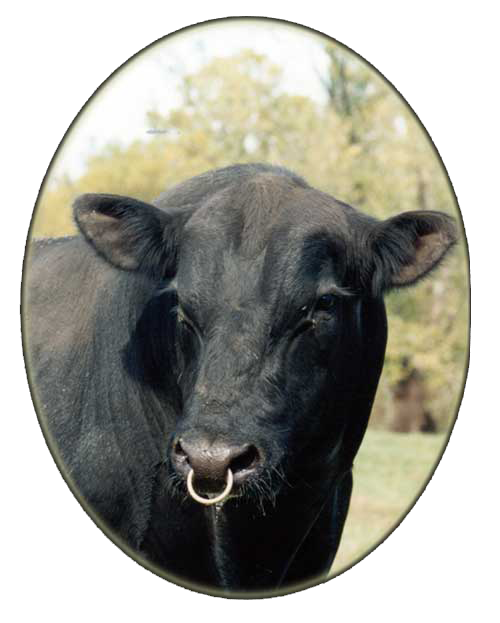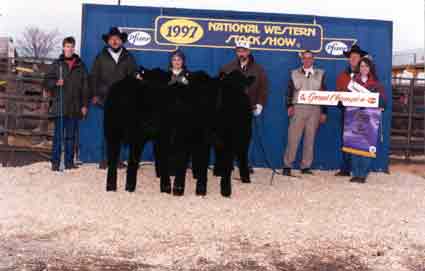HISTORY OF WILLOW OAK RANCH
Excerpt from Cattle Today article, Volume 8, Number 7 - December 10, 1994.
Willow Oak Chiangus:
Bottom line genetics for profit-minded producers
by: John Purdy
Special Correspondent
Near the foothills of East Tennessee, in the winding river valley of the Holston River, approximately 300 Chiangus brood cows are grazing on native grass pastures. These black, polled functional females are the production units for Willow Oak Chiangus Ranch. At Willow Oak, production of Chiangus seedstock is their only business. Since 1982, this Rogersville, Tenn., ranch has a program of producing reliable useful genetics for commercial cattlemen. This program focused, from the beginning, on the development of a hybrid Angus breed called Chiangus. "The concept was not original with me," says Richard Arnold, owner of Willow Oak Chiangus Ranch. "This breed was several important pioneers, but the person most responsible for our involvement was George Wheeler of Allandale Angus fame." (Editor note: see Cattle Today, Vol. 7, No. 6 for article on George Wheeler.)
Willow Oak's original plan was to breed performance oriented Angus cattle, but back in '82, George Wheeler, a long-time Angus breeder told Arnold of his dream for a hybrid Angus breed - to put an end to expensive and herd-mongrelizing cross-breed programs and keep black polled Angus-type cattle at the forefront of the modern industrialized cattle industry. Wheeler suggested that Arnold concentrate his efforts on developing a hybrid breed of Angus called, Chiangus.
"The cattle are lean meat, high yielding Angus-type cattle," says Richard Arnold. "Our goal from the beginning was to develop a new breed of cattle - bred for today's cattle industry which means production efficiency and lean meat performance."
The results have been eye opening. Willow Oak customers have reported impressive results for Chiangus steers. Through the National Cattlemen's Association's Strategic Alliances Field Study, Chiangus breeders have been able to verify by an independent third party (NCA) that, in Arnold's words, "Chiangus steers are unequaled in bottom line performance and profitability."
In the NCA Strategic Alliances Field Study, two pens of Chiangus steers averaged $161 per head profit compared to $55 per head on the other 13 pens of high-quality steers from reputation herds from Western Cattle Country. These results were duplicated two consecutive years by Chiangus steers in the Texas A&M Ranch to Rail Program. These steers in the Strategic Alliances program and the Texas A&M program come from three different cattle ranches in Nebraska, South Dakota and Texas. The only thing these operations have in common are that the steers are Chiangus and each are bull customers of Willow Oak Chiangus Ranch of Rogersville, Tennessee.
Willow Oak has successfully marketed performance-tested Chiangus bulls from Texas to Montana, Nebraska, North Dakota, South Dakota and nearer home throughout the Southeast.
* * * * * *
To develop a composite breed, Willow Oak has taken some of the most impressive performance genetics in the history of the cattle industry and applied both modern and old fashion breeders techniques to produce the high-tech cattle called Chiangus. Here is how - (Excerpt from Cattle Today, article Volume 11, Number 10 - February 7, 1998)
For other breeders who would like to understand how Willow Oak accomplished this consistency, what can you tell us about how this happened?
The number one thing is we developed a program based on information (data) and good cattleman's sense (functional and structural correctness), used good genetics and didn't fool ourselves. We have been faithful to our system and honest with ourselves. We started in 1982 to develop lean meat, high grading-high yielding Angus-type cattle. We accomplished this by using Angus cattle to develop a hybrid breed. We moved beyond crossbreeding because crossbreeding is the number one enemy of consistency and predictability. Anyone who visits our herd or attends our sale, the first thing they observe is the consistency of the cattle. I mean consistency of appearance, deep bodied black cattle - consistency of temperament -consistency of data-high marbling scores, ample ribeye measurement and low fat cover. This is no accident. We started with genetics that contained those characteristics and blended them in a live breeding program that has produced the predictability that we have today.
This all sounds good but there have bound to have been problems.
Of course there have been problems. This is the cattle business - but we have been fortunate. I have had the advice of two outstanding cattlemen. George Wheeler, a retired Angus breeder who first urged me to accept the challenge of producing a Hybrid Angus that could meet the challenges of value based marketing and John Coble of Billings, Montana, who knows more about the breeding of livestock than anyone I have ever met or read about. Between these two, we have been able to keep the ranch and our program headed in the right direction. The cattle industry has changed in many respects but one thing that has not changed is the art of breeding cattle. We have more tools, more information and more data. This presents greater opportunity but it does not change the fundamentals of breeding livestock. Consistent quality is obtained by breeding the best to the best. John Coble's skill has been critical and George Wheeler's perspective has been important. Together, we have produced this very important product-hybrid genetics with purebred predictability.
What type of problems have you encountered in developing your breeding program?
Well, the first problem that you encounter when you undertake the challenge of developing a hybrid breed is convincing potential customers that your cattle have value and that there is a reason to try your bulls. This has been a long, slow process; but the success of our past sales stand as a testament to the fact that our cattle do provide real value to our customers. We have the data to prove it and we have over 200 bulls in cow herds around the country to confirm the value of our cattle. This is no longer a problem. Our customers are our best advertisement.
The second problem we encountered was a negative impression regarding the temperament of some Chi x Angus cattle from the steer show days. Many people believed these cattle to be up-headed and nervous. That is a problem we have tackled head on. It speaks simply to the proper use of the breeders art - the use of selection pressure to remove any potential temperament problems. We have so effectively eliminated that problem that we have our sale cattle in groups of three in open pens for inspection on the day before and the day of our sale. The most common compliment we receive is the soundness of the cattle's temperament.
This was accomplished through the use of a temperament rating system. The Willow Oak cow herd is rated on temperament. Every member of Willow Oak staff provides a rating but final ratings are set by John Coble.
5 - Best Temperament
4 - Good Temperament
3 - Average Temperament
2 - Below Average Temperament
1 - Unacceptable Temperament
Cows that fit in categories 1, 2 and 3 are long gone from Willow Oak. Categories 1, 2 and 3 are only used to identify any weaned calves that fit those categories. There are very few 1 or 2's in the calf crop any more. At our 2000 sale, the number-one comment by those in attendance was the docile, easy-going nature of the Willow Oak cattle. That is the direct result of this temperament rating system. The temperament rating on the sire and dam of each bull at the sale is provided for the customers' use.
* * * * * *
Generally, the cattle business is local in nature, but Willow Oak has bull customers in Texas, Montana, North & South Dakota, Nebraska, Missouri and all of the southeastern states. Back in the 1980's and early 1990's, we used to hear a lot of criticism about southeastern cattle being inferior. In 1997, in an attempt to demonstrate in the west that the myth about southeastern cattle not being up to western standards was not true, we took a pen of bulls to the Great Western prestigious Pen of Bulls contest.
|
||||||||||||||||||||||||||||||||||||||||||||||||||

